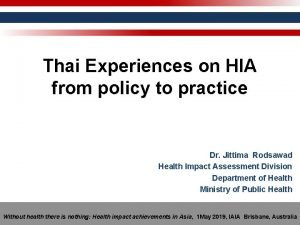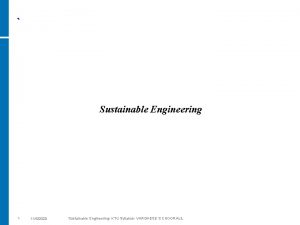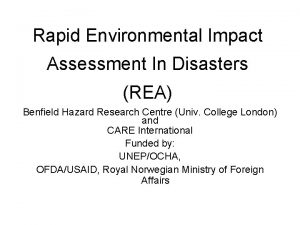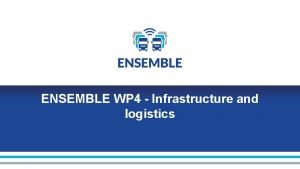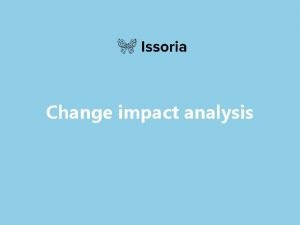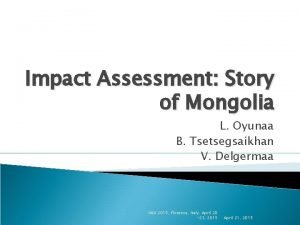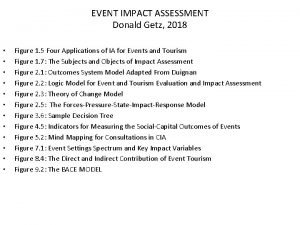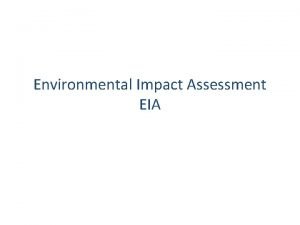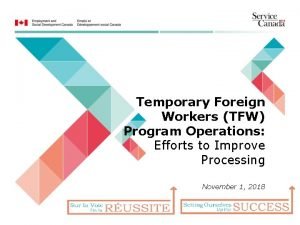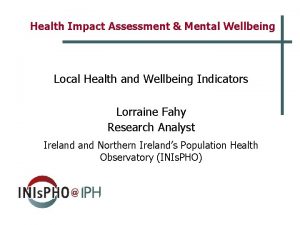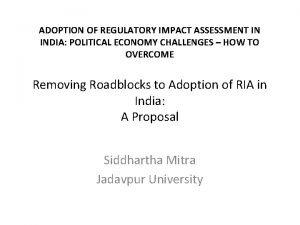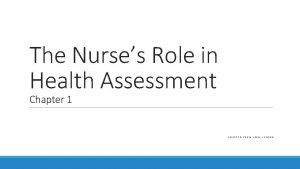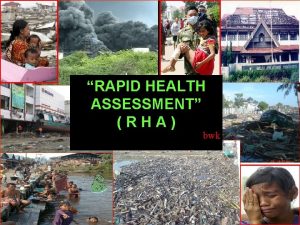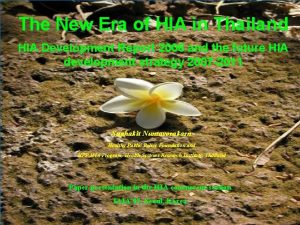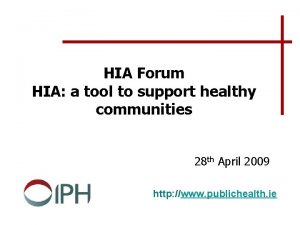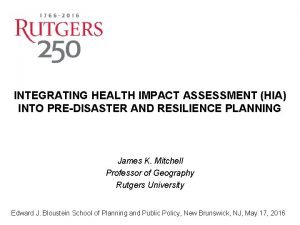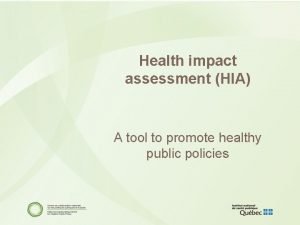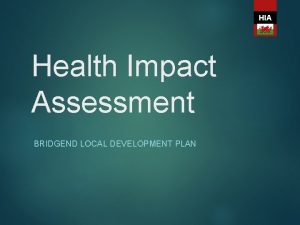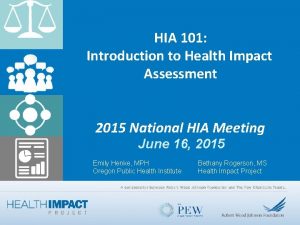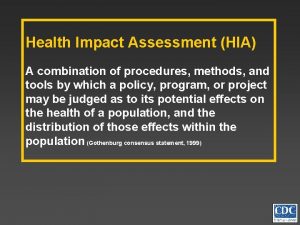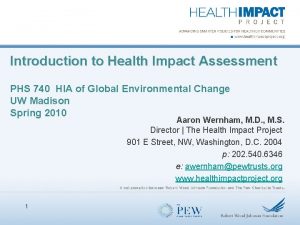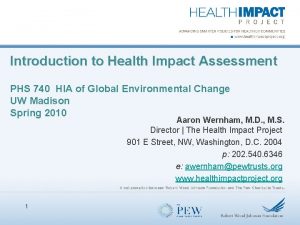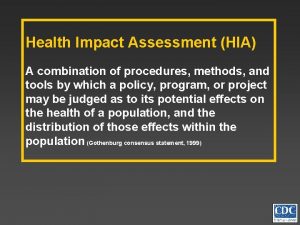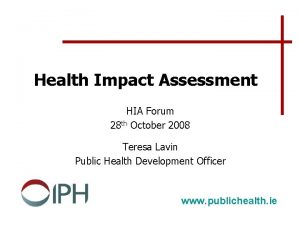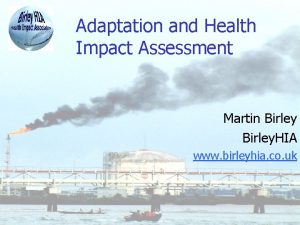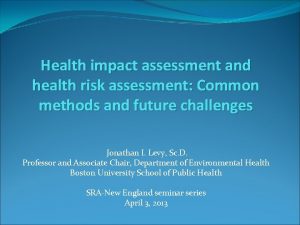HOW TO DO HIA Health Impact Assessment HIA



















- Slides: 19

HOW TO DO HIA?

Health Impact Assessment (HIA) A combination of procedures, methods and tools by which a policy, programme or project may be judged as to its potential effects on the health of a population, and the distribution of those effects within the population. WHO, European Centre for Health Policy. Gothenburg Consensus Paper, Health Impact Assessment- main concepts and suggested approach. Brussels, 1999.

Why use HIA? We have to think about the effects policies have on health, and in particular, how they can alter the health of all people in the population. Non-health sector proposals, where health is not the main objective, may have major effects on the health and wellbeing of people, particularly vulnerable groups. Source: WHO, European Centre for Health Policy

HIA explained � HIA is an approach that gets people to think about what they are doing, and how it may alter people’s health. It promotes health – and in the long term contributes to the health of local people � Imagine someone was planning to build a new motorway. An HIA would answer ‘How would this new development affect people’s health? ’ Source: WHO, European Centre for Health Policy

An HIA would ask…. � Would the motorway increase or decrease noise, air or light pollution? � How would the motorway affect local businesses and jobs? � Would the new motorway reduce or increase the stress for local people? � How would a new motorway change the local infrastructure needs - and would this be good or bad for local people? Source: WHO, European Centre for Health Policy

The purpose/function of HIA is to: � Inform � Help and influence the decision maker. address inequalities in health. � Promote � Place joined-up working. public health on the agenda. � Reduce conflict between stakeholders. � Encourage sustainable development.

HIA does this by: � � � Using a broad understanding of health. Using a participatory approach that considers which stakeholders need to be involved Helping involve local people in decisions and responding to their concerns about health. Considering different types of evidence - from local views to scientific information. Assessing how the proposal will affect all members of the community – particularly the most vulnerable. Assisting with sustainable development by considering short and long term impacts. Source: WHO, European Centre for Health Policy

HIA Here is a selection of HIA-related research and examples, grouped under resource/evaluation type and subject area. � � � � Agriculture Air Culture Development Energy Housing Integrated impact assessment Mining Noise Other subjects Overview Social welfare Tourism Transport and communications Waste Water

HIA…. . � Guidance documents often break HIA into four, five or six stages. Despite the differing number of stages, there are no significant differences between the methods. � The theoretical stages often overlap and intermingle, and a clean separation is not often obvious in practice. The stages are:

HIA Procedure Screening Policy and Programme development phase for prospective assessments Policy Scoping Identifies key health issues and public concerns, establishes To. R, sets boundaries. Appraisal Rapid or in-depth assessment of health impacts using available evidence-who will be affected, baseline, prediction, significance , mitigation. Reporting implementation phase Source: WHO, HIA, 2013 Quickly establishes ‘health relevance’ of the policy or project. Is HIA required? Monitoring Conclusion and recommendations to remove /mitigate negative impacts on health or to enhance positive. Action, where appropriate, to monitor actual impacts on health to enhance existing evidence base.

The HIA procedure: Screening 1. Screening- Identifying if an HIA should occur q q q ü ü ü It is not possible to carry out an HIA on every project, policy or programme. Therefore screening is used to systematically decide when to do an HIA. In practice screening is not used often; resource and organisational issues. Screening only works when there is organisational commitment to HIA – where management allow the time and resource to screen each project, policy or programme. Typically, the decision to carry out an HIA comes about in other ways: A significant project is occurring, and someone (the developer, the public, local public health, planners, etc. ) think an HIA would be a good idea. Funding is received for carrying out an HIA, and a single topic is chosen. To do an HIA on all major issues (for example the London Mayoral Strategies).

The HIA procedure: Scoping 2. Scoping-Identifying what to do and how to do it Scoping sets the boundaries for, and considers how the HIA appraisal stage should be undertaken. some typical scoping issues to be considered are: � Who will do the HIA and who will be in charge? � Are there any specialists or practitioners who could be involved? � What monitoring and evaluation of the HIA will occur? � � When does the HIA have to be done by, to influence key decision makers (often influencing the choice of whether a rapid or comprehensive HIA is undertaken)? Setting and agreeing the aims and objectives of the HIA.

The HIA procedure: Appraisal 3. Appraisal-Identifying health hazards and considering evidence of impact � � this is where a large amount of HIA work is carried out. the best available qualitative and quantitative evidence are collated using a range of methods, including interviews, focus groups, surveys and community profiling (to name a few). facilitated workshops are held to appraise the evidence. Drawing together a wide range of stakeholders allows different views to emerge and helps develop partnership working.

The HIA procedure: Reporting 4. Reporting-Developing recommendations to reduce hazards and/or improve health. �A key output of HIA is the set of recommended changes to the proposal. � Conclusions and recommendations to remove/mitigate negative impacts or to enhance positive are compiled.

The HIA procedure: Evaluation and Monitoring 5. Evaluation and Monitoring � Evaluating whether the HIA has influenced the decision making process (and the subsequent proposal) is an important component of HIA. � Also useful to answer why the HIA worked (or not). � Monitoring the implementation of the proposal is critical; to ensure recommendations that decision-makers agreed to, actually occur. � Longer term monitoring of the health of populations is sometimes a component of larger proposals; To see if the predictions made during the appraisal were accurate, and if the health, or health promoting behaviours, of the community have improved.

Barriers cited & solutions to using HIA in Government policy making Lack of relevant Ø skills and expertise Lack of awareness Ø and understanding Develop skills by taking part in free online trainings and reading more information on WHO site. Send people to WHO website for a quick introduction. Download the ‘short guides’ and provide them. Free online trainings available. v Lack of resources and time Ø If priority is placed on HIA, resources will follow. Using rapid appraisal techniques, and only doing a ‘desk-top HIA’ – where community consultation does not occur, are other ways to undertake an HIA when resources are limited. v Lack of political support Ø Use completed HIAs to show HIA has been used in other countries/organisations v v . v Other priorities get Ø Use the ‘why use hia’ facts to pick factors most suited to your organisation/sector and use these in awareness raising activity. in the way v Not convinced of benefits Gaps in the evidence base v Ø Ø The evaluated benefits are being shown. HIAs have a sound evidence base that they work. The use of the best available evidence is better than not using any evidence at all. HIA draws on the best available evidence and summaries are being done to draw evidences together.

Canadian context � � � The EIA evolved for over 25 years in Canada, but it was felt in early 1990 s, that EIA paid inadequate attention to possible consequences for human health. Independent reviews on HIA implementation nationally and internationally indicated that the health aspects with EIA were inconsistently or partially addressed and more systemic approach was needed A task force on HIA was set up in Canada by Federal, Provincial and Territorial Advisory on Population Health(FPTACPH). In Canada approximately 5000 development projects underwent EIA annually and HIA was to be integrated with EIA processes but guidance material on HIA was not available The Canadian hand book on HIA was written in 1996 (3 volumes), rewritten in 2004 and released online. Kemm, John; Parry, Jayne; Palmer, Stephen. (2004). Health Impact Assessment: Concepts, Theory, Techniques and Applications. Oxford Medical Publications. . Oxford University Press. Retrieved 20 February 2013

� HIA: Resources How to undertake an HIA http: //www. who. int/hia Canadian Handbook on Health Impact Assessment available online at http: //www. hc-sc. gc. ca/fniahspnia/pubs/promotion/_environ/handbookguide 2004/index-eng. php � Various examples of evidences for use in HIA and Evaluation tools can be found at http: //www. who. int/hia/evidence/en/ � Health Impact Assessment in Practice is a free e-learning course provided by Health Scotland. For more information visit: elearning. healthscotland. com � The International Health Impact Assessment Consortium (IMPACT) is based in the Division of Public Health, a WHO Collaborating Centre at the University of Liverpool, UK. � IMPACT delivers a 5 -day HIA training programme twice a year, as well as a Masters module which is part of Liverpool University's Masters of Public Health programme. For more information visit: www. ihia. org. uk �

� Thanks � ?
 Hia in thai
Hia in thai Mcn 201 sustainable engineering ktu syllabus
Mcn 201 sustainable engineering ktu syllabus Business continuity software integration with hp
Business continuity software integration with hp Cipd experience assessment
Cipd experience assessment Rapid environmental impact assessment in disaster
Rapid environmental impact assessment in disaster Traffic impact assessment
Traffic impact assessment Change impact assessment template
Change impact assessment template What is environmental impact
What is environmental impact Event impact assessment
Event impact assessment Eia processes
Eia processes Labour market impact assessment lmia online web application
Labour market impact assessment lmia online web application Mental wellbeing impact assessment
Mental wellbeing impact assessment Mental wellbeing impact assessment
Mental wellbeing impact assessment Regulatory impact assessment india
Regulatory impact assessment india Principle of portfolio assessment
Principle of portfolio assessment Define dynamic assessment
Define dynamic assessment Portfolio assessment matches assessment to teaching
Portfolio assessment matches assessment to teaching Assessment skills
Assessment skills Subjective assessment examples
Subjective assessment examples Health assessment adalah
Health assessment adalah
